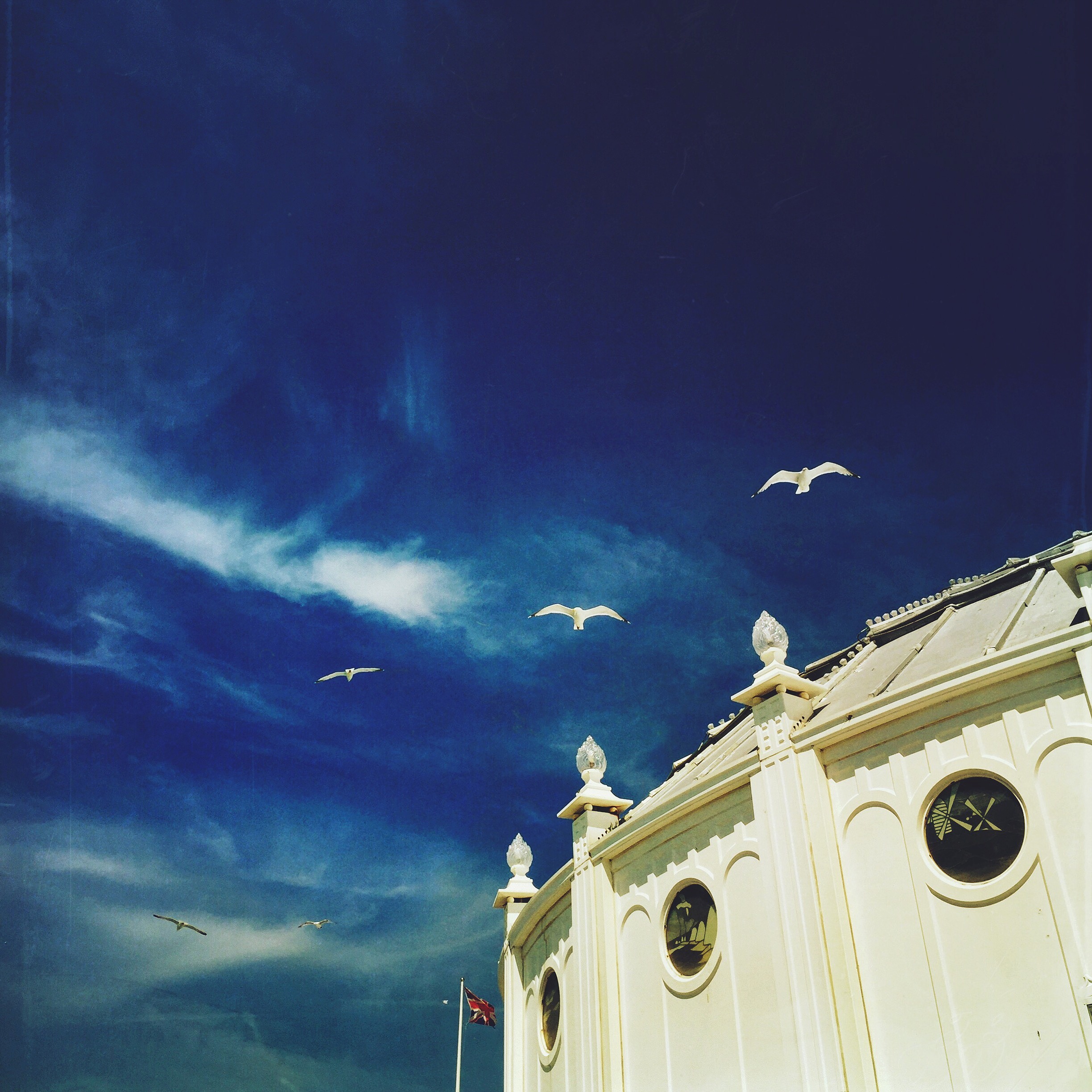BRIGHTON
The morning is cool and soft, the air riddled with brine. I stand in Brighton Station amid a swirl of travelers and muffled announcements, cradling my still-warm coffee, slightly stunned at how quickly I’ve arrived. The train ride from London couldn’t have been much more than an hour. I pluck a map from the nearby kiosk and join the steady stream of people flowing south toward King’s Road where, I find cheerful things all in a row—a gleaming pier, string of pubs, £2-a-day beach chairs, even a Ferris wheel. A smile unfurls as I squint into the gauzy air. My dream of the English seaside is real.
*
In the mornings, I eat at a café in the artists quarter. The owners are a charming pair; she is quiet and reserved, the epitome of warmth in her flowered apron. Her husband greets patrons with a hearty, booming voice.
“There you are, my darling,” he says, setting coffee at my elbow. “Stay as long as you like, no need to rush off.”'
His wife makes the rounds; straightening, serving. She stops to stare out at the sea from time to time. If I happen to look up, she breaks from her reverie and asks, “Alright, love?”
“You’re a proper bookworm,” the man says one morning, nodding at my borrowed copy of Larkin poems. “Is poetry your thing?”
“That and history,” I reply.
He says if it’s history I fancy, I ought to take a peek in their local fishing museum. “It’s just down the way,” he says, with a jab of his thumb. “More than you ever wanted to know about Brighton, and then some.”
I thank him for this suggestion. And when the last crumb of my pan au raisin has been devoured and my coffee drained, off I go.
*
IN WHICH I LEARN MUCH ABOUT BRIGHTON’S HISTORY
From its humble beginnings as a fishing enclave, Brighton evolved into one of England’s prime leisure destinations. Royals were among its first visitors; the town boasts a Mughal-inspired palace built in the 1700’s by Prince George IV who favored Brighton for the sun and sea air (but also, because it was an ideal place to rendezvous with his mistresses).
In the 19th century, an influx of tourists inspired Brighton’s fishermen to offer sailing cruises( after pulling up nets for the day) on their hastily scoured “pleasure boats”. Closer to shore, aristocrat ladies soaked discreetly and claustrophobically inside bathing machines—tiny, canvas-roofed houses wheeled into the frigid waters by enterprising locals who charged them dearly for the service.
With each new era, came new diversions—diving clubs, swimming contests, regattas. The Golden Age of pier-building dawned in the mid-1800’s. Brighton’s Piers were places of glamor and culture where people went to dine, dance, and socialize. A theater was built, then a concert hall. Musicians and artists added Brighton to the circuit; Punch and Judy enlivened the weekend set. Brighton’s West Pier enjoyed its peak of popularity in 1918, when as many as two million people visited. Today, only one Pier remains—the Brighton or “Palace” Pier. The skeleton of the once-dazzling West Pier (ruined by fire in the 1970’s) still stands in the southern surf but sadly, is beyond repair.
*
I find a canvas lounger next to a railing and settle in with a pint, feet propped, wind whipping my hair into a flag. In the water below, three boys backflip off the stern of a speedboat, each one surfacing in a sudden, dramatic spray. They perform for hours, like glistening harbor seals.
*
As in every new place, my joy lies in walking. One afternoon, I stop to lace my fingers through the fence at Pavilion Gardens and stare in at the city’s largest architectural oddity—The Royal Pavilion, George IV’s epic “pleasure palace”—a sprawling edifice adorned with Indian minarets and ornamental arches befitting a Maharaja. It is visually stunning. Glorious, even. Yet, absurdly out of place.
I walk around to the entrance and pay a bored-looking teenager £18. She hands me a headset, an audio player and advises three hours for the tour, should I wish to do it properly.
INSIDE THE ROYAL PAVILION
England’s King George IV (b.1762 — d.1830) built the Royal Pavilion while in the throws of an affair with Maria Fitzherbert, a woman some years older whom he considered “the wife of his heart and soul”. They later married in secret, then drifted apart, and lovelorn George pursued dalliances with a chain of random women. George’s truest romance, however may well have been with his Pavilion. He spared no expense, enlisting renowned architect, John Nash and interior designer, Frederick Crace to bring his vision to life.
The visual drama of the palace unfolds with theatrical flourish, beginning in the Long Gallery where visitors are met with an array of illusory textures: enigmatic Chinese “nodding figures”, simulated bamboo furniture and enfiladed “infinity” mirrors. This is followed by the exotic landscape of the banquet hall, filled to bursting with thousand-shell chandeliers, faux palm trees, dragon-shaped lanterns and floor-to-ceiling tapestries infused with secret freemason symbols (George IV was the first freemason to become the King of England).
Thrilling to the eye? Yes. Aesthetically confusing? Extremely. At first, the palace feels almost manic—is it Neoclassical? Gothic? Chinese? But three hours and two floors later, it ceases to matter. Its beauty lies in its exquisite wildness; its blunt rejection of propriety.
As for George IV, his love of the bright and bizarre garnered him few fans. He was scorned for his gluttonous lifestyle and eventually died—blind, obese and heirless—attended only by his page at stately Windsor Castle, a world away from his seaside playground of mercurial delights.
*
I stumble back out into the still-bright afternoon, mind ablaze with the exotic colors of George’s Indo-Chinese palace. Amid an eclectic string of shops in The Lanes, I find a woman selling Miao jewelry—exquisite designs of hammered metal and cloth, traditionally made in China’s Guizhou province.
I point to a beautiful ring in her display case. “Miao?” I ask (painfully aware that I sound like a cat).
“Yes! Please look.” She regards me with interest.
As I move closer my eyes catch upon a second piece—a silver cuff with a tribal motif. Before I can speak, she deftly slides it onto my wrist.
“Looks so good,” she murmurs sagely.
I nod and stifle a laugh. And know that I will be £15 lighter on the way home.
*
Evening drifts down. The aroma of toasted bread and curry chicken stops me in my tracks and I join the queue at a baguette stand in the park. Somehow, I unearth £2 from the bottom of my bag and a man hands me a bag crinkling with savory heat. Clutching it to my chest, I rejoin the expanding surge of foot traffic. The loose strands of day-trippers have swelled into high-spirited crowds on St. James Street, now a river of shouts and jostling limbs; jubilant voices heralding the start of the weekend.
After dinner, I sit coiled by the window, a mug of tea steeping lazily on the sill as I conjure moments for later use: mornings at the cafe, the cozy sag of my beach chair, gulls squawking above the implausibly blue sea ...
Night arrives, a lavender bowl of sky that deepens to black. It is just me now, I think, with my book and my tea and these two pale birds tussling on a branch, but then—a punch of laughter from the pub below, whistle of a kettle, the red, pulsing dot of a plane as it glides above the treetops.
Far beyond these tiny explosions, the heavens begin to fill with slow-blossoming stars—a vain, defiant clamoring in the southern English sky. And I am reminded that no matter how solo my travels are, it is never just me.
F I N
If you fancy more Brighton photos ...


























